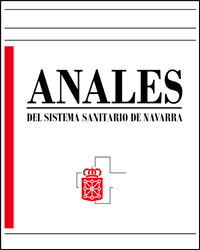Sentinel node in breast cancer. Histological study of 67 cases
DOI:
https://doi.org/10.23938/ASSN.0473Keywords:
Ganglio centinela. Carcinoma de mama. Queratina.Abstract
Background. The extirpation of the sentinel node is a widespread surgical technique whose aim is to avoid axillary resection in patients with breast cancer at early stages. Determination of tumoral infiltration can be evident in the case of macrometastasis (>2mm), or difficult to detect in micrometastasis (<2mm). For this reason we use a protocol of serialized sections, to increase our capacity for detecting micrometastasis. Realisation of this protocol is highly laborious and represents a high cost, thus its effectiveness and efficacy must be studied. Material and methods. We reviewed 67 sentinel nodes corresponding to 48 patients with breast cancer treated at our hospital in the last three years. All the samples received at the Pathology Unit were included. Serialized sections of three microns were made on each node and with a depth of 40 microns between them. A total of fourteen cuts were made. Every five cuts there was an alternation of immunostaining with a cocktail of queratines (AE1/AE3) and with haemotoxylin-eosin. Results. Sixty-seven sentinel nodes were extirpated from 48 patients. Fourteen positive (20%) were detected. Of these metastases, 6 were macrometastases >2mm, 5 were micrometastases <2mm and 3 were isolated cellular groups (between 0.2 and 2mm). In 6 cases (43%), the metastases only became evident with queratine staining in serialized cuts. Axillary resection was carried out in 44 cases. Conclusions. The histological study of the sentinel nodes makes it possible to evaluate the status of tumoral infiltration of the axillary ganglions and to greatly reduce axillary lymphadenectomies. The conventional study of the sentinel node (with a single section) is insufficient for the diagnosis of tumoral infiltration. In our series, histological study using a protocol of serialized sections has enabled us to detect some 43% of metastases in the sentinel node that were not evident in the initial section.Downloads
Downloads
Published
How to Cite
Issue
Section
License
La revista Anales del Sistema Sanitario de Navarra es publicada por el Departamento de Salud del Gobierno de Navarra (España), quien conserva los derechos patrimoniales (copyright ) sobre el artículo publicado y favorece y permite la difusión del mismo bajo licencia Creative Commons Reconocimiento-CompartirIgual 4.0 Internacional (CC BY-SA 4.0). Esta licencia permite copiar, usar, difundir, transmitir y exponer públicamente el artículo, siempre que siempre que se cite la autoría y la publicación inicial en Anales del Sistema Sanitario de Navarra, y se distinga la existencia de esta licencia de uso.








